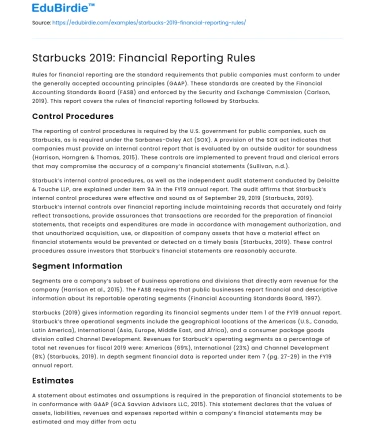Rules for financial reporting are the standard requirements that public companies must conform to under the generally accepted accounting principles (GAAP). These standards are created by the Financial Accounting Standards Board (FASB) and enforced by the Security and Exchange Commission (Carlson, 2019). This report covers the rules of financial reporting followed by Starbucks.
Control Procedures
The reporting of control procedures is required by the U.S. government for public companies, such as Starbucks, as is required under the Sarbanes-Oxley Act (SOX). A provision of the SOX act indicates that companies must provide an internal control report that is evaluated by an outside auditor for soundness (Harrison, Horngren & Thomas, 2015). These controls are implemented to prevent fraud and clerical errors that may compromise the accuracy of a company’s financial statements (Sullivan, n.d.).
Save your time!
We can take care of your essay
- Proper editing and formatting
- Free revision, title page, and bibliography
- Flexible prices and money-back guarantee
Starbuck’s internal control procedures, as well as the independent audit statement conducted by Deloitte & Touche LLP, are explained under Item 9A in the FY19 annual report. The audit affirms that Starbuck’s internal control procedures were effective and sound as of September 29, 2019 (Starbucks, 2019). Starbuck’s internal controls over financial reporting include maintaining records that accurately and fairly reflect transactions, provide assurances that transactions are recorded for the preparation of financial statements, that receipts and expenditures are made in accordance with management authorization, and that unauthorized acquisition, use, or disposition of company assets that have a material effect on financial statements would be prevented or detected on a timely basis (Starbucks, 2019). These control procedures assure investors that Starbuck’s financial statements are reasonably accurate.
Segment Information
Segments are a company’s subset of business operations and divisions that directly earn revenue for the company (Harrison et al., 2015). The FASB requires that public businesses report financial and descriptive information about its reportable operating segments (Financial Accounting Standards Board, 1997).
Starbucks (2019) gives information regarding its financial segments under Item 1 of the FY19 annual report. Starbuck’s three operational segments include the geographical locations of the Americas (U.S., Canada, Latin America), International (Asia, Europe, Middle East, and Africa), and a consumer package goods division called Channel Development. Revenues for Starbuck’s operating segments as a percentage of total net revenues for fiscal 2019 were: Americas (69%), International (23%) and Channel Development (8%) (Starbucks, 2019). In depth segment financial data is reported under Item 7 (pg. 27-29) in the FY19 annual report.
Estimates
A statement about estimates and assumptions is required in the preparation of financial statements to be in conformance with GAAP (GCA Savvian Advisors LLC, 2015). This statement declares that the values of assets, liabilities, revenues and expenses reported within a company’s financial statements may be estimated and may differ from actual results.
Starbuck’s statement of estimates and assumptions can be found under Note 1 of the FY19 consolidated financial statements. In this note Starbucks declares that estimates may be applied (but not limited) to inventory reserves, asset and goodwill impairments, assumptions underlying self-insurance reserves, income from unredeemed store value cards, stock-based compensation forfeiture rates, future asset retired obligations and the potential outcome of future tax consequences of events that have been recognized in financial statements (Starbucks, 2019). This statement disclaims that estimates and assumptions are used in the FY19 report and that reported values may not completely reflect actual results.
Investments and Fair Value
Assessing and measuring fair value reported on a company’s financial statement is required by the FASB in order to comply with GAAP. It is defined under topic FASB ASC 820, which states that “fair value is the price that would be received to sell an asset or paid to transfer a liability in an orderly transaction between market participants at the measurement date.” (Minotti, 2016). This fair value measurement consists of a three-level hierarchy for reporting. Level 1 fair values are the quoted prices directly comparable to identical assets in an active market at the measurement date, level 2 values are the significant observable inputs that are not quoted prices, and level 3 values are the significant unobservable inputs unique to a company ('Fair value hierarchy leveling' n.d.).
Starbucks statement of fair values is found in Note 1 of the FY19 report, where the company policy for each hierarchy is defined in detail. Financial values and further explanation of level 3 assets and liabilities are found in Note 4 of the FY19 report. The total asset fair value balance in 2019 is $3016.0 million and the total liability fair value balance in 2019 is $18.2 million (Starbucks, 2019). These total values are broken into the three-level hierarchy and reported under Note 4.
Leases
In 2016, the FASB implemented a new standard that requires organizations that lease assets to recognize on the balance sheet the assets and liabilities for the rights and obligations created by those leases ('Leases,' n.d.).
Starbucks (2019) states that their leases consist of retail stores, roasting, distribution and warehouse facilities and office space for corporate administrative purposes under operating leases. Values for lease amounts are reported under Note 10 of Starbuck’s FY19 consolidated financial statements. Total rent expenses were $1666.0 million in 2019, and $1625.2 in 2018 (Starbucks, 2019).
References
- Fair value hierarchy leveling. (n.d.). Retrieved from https://data.bloomberglp.com/professional/sites/10/Fair-Value-Hierarchy-Leveling-Fact-Sheet.pdf
- Financial Accounting Standards Board. (1997). Disclosures about segments of an enterprise and related information. Retrieved from https://www.fasb.org/summary/stsum131.shtml
- GCA Savvian Advisors LLC. (2015, December 31). Notes to financial statements. Retrieved from https://www.sec.gov/Archives/edgar/data/1254219/000125421916000005/notes1.pdf
- Harrison W., Horngren C. T., Thomas C. W. (2015). Financial accounting (10th ed.). New York, NY: Pearson Education
- Leases. (n.d.). Retrieved from https://www.fasb.org/leases#section_2
- Minotti, S. (2016, July 6). Understanding FASB ASC 820 – and important proposed changes. Retrieved from https://blog.skodaminotti.com/understanding-fasb-asc-820-important-proposed-changes/
- Starbucks. (2019). FY19 annual report. Retrieved from https://s22.q4cdn.com/869488222/files/doc_financials/2019/2019-Annual-Report.pdf
- Sullivan, D. (n.d.). GAAP Principles for Internal Control Procedures. Retrieved from https://smallbusiness.chron.com/gaap-principles-internal-control-procedures-63102.html






 Stuck on your essay?
Stuck on your essay?

